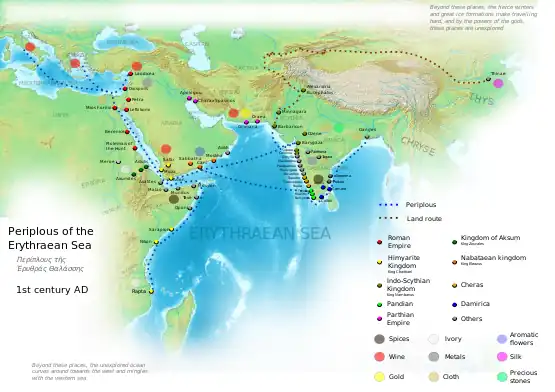
Map showing commercial settlements described in the Periplus of the Erythraean Sea and the Periplus of Hanno.
Wilfred Harvey Schoff (1874–1932) was an early twentieth-century American antiquarian and classical scholar.[1]
Career
Schoff was responsible for translating a number of important ancient texts. Among these works was the 1st century CE Greco-Roman Periplus of the Erythraean Sea,[2] as well as the Carthaginian Periplus of Hanno.[3]
Besides writing, Schoff also served as Secretary of the Philadelphia Commercial Museum.
Works
- Schoff, Wilfred H., The Periplus of Hanno: A Voyage of Discovery Down the West African Coast, by a Carthaginian Admiral of the Fifth Century B.C. (Philadelphia: Commercial Museum, 1912).
- Schoff, Wilfred H., The Periplus of the Erythraean Sea: Travel and Trade in the Indian Ocean, by a Merchant of the First century (New York City et al.: Longmans, Green, and Co., 1912)
- Schoff, Wilfred H., The descendants of Jacob Schoff who came to Boston in 1752 and settled in Ashburnham in 1757 : with an account of the German immigration into colonial New England (Philadelphia : [J. McGarrigle], 1910)
- Schoff, Wilfred H. The eastern iron trade of the Roman empire. ([New Haven], 1915)
- Schoff, Wilfred H., The ship "Tyre"; a symbol of the fate of conquerors as prophesied by Isaiah, Ezekiel and John and fulfilled at Nineveh, Babylon and Rome; a study in the commerce of the Bible, (New York City Longmans, Green and co., 1920)
- Schoff, Wilfred H., Periplus of the Outer Sea, east and west, and of the great islands therein, by Marcian of Heraclea, Philadelphia, 1927.
References
- ↑ Wilfred Harvey Schoff at the University of Pennsylvania library website
- ↑ Schoff, Wilfred H. (Wilfred Harvey), 1874-1932, ed.: The Periplus of the Erythraean Sea: Travel and Trade in the Indian Ocean, by a Merchant of the First Century (New York et al.: Longmans, Green, and Co., 1912)
- ↑ Schoff, W. H., The Periplus of Hanno: A Voyage of Discovery Down the West African Coast, by a Carthaginian Admiral of the Fifth century BC. (Philadelphia: Commercial Museum, 1912)
This article is issued from Wikipedia. The text is licensed under Creative Commons - Attribution - Sharealike. Additional terms may apply for the media files.